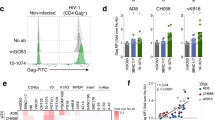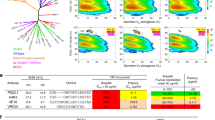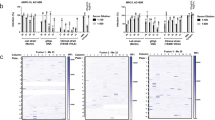Abstract
THE human immunodeficiency virus type 1 (HIV-1) exploits the cell surface CD4 molecule to initiate the infection1–4 which can lead, eventually, to acquired immunodeficiency syndrome (AIDS). The HIV-1 envelope protein, gp120, interacts specificially with CD4 and soluble CD4 molecules have been shown to inhibit HIV infectivity in vitro5–9. Effective inhibition in vivo may, however, require more potent reagents. We describe here the generation of molecules which combine the specificity of CD4 and the effector functions of different immunoglobulin subclasses. Replacing the VH and CH1 domains of either mouse γ2a or µ. heavy chains with the first two N-terminal domains of CD4 results in molecules that are secreted in the absence of any immunoglobulin light chains. We find that the pentameric CD4–IgM chimaera is at least 1,000-fold more active than its dimeric CD4–IgG counterpart in syncytiurm inhibition assays and that effector functions, such as the binding of Fc receptors and the first component of the complement cascade (Clq), are retained. Similar chimaeric molecules, combining CD4 with human IgG were recently described by Capon et al.10, but these included the CH1 domain and did not bind Clq. Deletion of the CH1 domain may allow the association and secretion of heavy chains in the absence of light chains11, and we suggest that the basic design of our constructs may be generally and usefully applied.
This is a preview of subscription content, access via your institution
Access options
Subscribe to this journal
Receive 51 print issues and online access
$199.00 per year
only $3.90 per issue
Buy this article
- Purchase on Springer Link
- Instant access to full article PDF
Prices may be subject to local taxes which are calculated during checkout
Similar content being viewed by others
References
Dalgleish, A. et al. Nature 312, 763–766 (1984).
Klatzmann, D. et al. Nature 312, 767–768 (1984).
McDougal, J. et al. J. Immun. 135, 3151–3162 (1985).
Maddon, P. J. et al. Cell 47, 333–348 (1986).
Smith, D. H. et al. Science 238, 1704–1707 (1987).
Fischer, R. A. et al. Nature 331, 76–78 (1988).
Hussey, R. E. et al. Nature 331, 78–81 (1988).
Deen, K. C. et al. Nature 331, 82–84 (1988).
Traunecker, A., Lüke, W. & Karjalainen, K. Nature 331, 84–86 (1988).
Capon, D. J. et al. Nature 337, 525–531 (1989).
Seligmann, M., Mihaesco, E., Preud Homme, J. L., Danon, F. & Brouet, J. C. Immun. Rev. 48, 145–167 (1979).
Classon, J. B., Tsagarotos, J., McKenzie, I. F. & Walter, I. D. Proc. natn. Acad. Sci. U.S.A. 83, 4499–4503 (1986).
Traunecker, A., Dolder, B., Oliveri, F. & Karjalainen, K. Immun. Today 10, 29–32 (1989).
Deisenhofer, Y. Biochemistry 20, 2361–2370 (1981).
Duncan, A. R. & Winter, G. Nature 332, 738–740 (1988).
Duncan, A. R., Woof, J. M., Partridge, L. J., Burton, D. R. & Winter, G. Nature 332, 563–569 (1988).
Sodroski, J., Goh, W. C., Rosen, C., Campbell, K. & Haseltine, W. A. Nature 332, 470–474 (1986).
Lifson, J. D. et al. Nature 323, 725–728 (1986).
Lasky, L. et al. Cell 50, 975–985 (1987).
Hahn, B. H. et al. Proc. natn. Acad. Sci. U.S.A. 82, 4813–4817 (1985).
Wong-Staal, F. et al. Science 229, 759–762 (1985).
Alison, M., Wain-Hobson, S., Montagnier, L. & Sonigo, P. Cell 46, 63–74 (1986).
Starcich, B. R. et al. Cell 45, 637–648 (1986).
Gelderblom, H. R., Reupke, H. & Pauli, G. Lancet ii, 1016–1017 (1985).
Schneider, J., Kaaden, O., Copeland, T. D., Oroszlan, S. & Hunsmann, G. J. J. gen. Virol. 67, 2533–2539 (1986).
Lyerly, H. K., Matthews, T. J., Langlois, A. J., Bolognesi, D. P. & Weinhold, K. J. Proc. natn. Acad. Sci. U.S.A. 84, 4601–4605 (1987).
Weinhold, K. J. et al. Lancet ii, 902–905 (1988).
Lanzavecchia, A., Roosnek, E., Gregory, T., Berman, P. & Abrignani, S. Nature 334, 530–534 (1988).
Siliciano, R. F. et al. Cell 54, 561–575 (1988).
Hoas, I. G. & Walb, M. Nature 306, 387–289 (1984).
Bole, D. G., Hendershot, L. M. & Kearney, L. F. Cell Biol. 102, 1558–1566 (1986).
Traunecker, A., Dolder, B. & Karjalainen, K. Eur. J. Immun. 16, 851–854 (1986).
Popovic, M., Samgadharan, M. G., Read, E. & Gallo, R. C. Science 224, 497–500 (1984).
Schneider, J. et al. Virology 132, 1–11 (1984).
Miyoshi, I., et al. Nature 294, 770–771 (1981).
Author information
Authors and Affiliations
Rights and permissions
About this article
Cite this article
Traunecker, A., Schneider, J., Kiefer, H. et al. Highly efficient neutralization of HIV with recombinant CD4-immunoglobulin molecules. Nature 339, 68–70 (1989). https://doi.org/10.1038/339068a0
Received:
Accepted:
Issue Date:
DOI: https://doi.org/10.1038/339068a0
This article is cited by
-
Highly robust protein production by co-culture of CHO spheroids layered on feeder cells in serum-free medium
Colloid and Polymer Science (2014)
-
HIV-1 evades antibody-mediated neutralization through conformational masking of receptor-binding sites
Nature (2002)
-
Receptors for polytropic and xenotropic mouse leukaemia viruses encoded by a single gene at Rmc1
Nature Genetics (1999)
-
Synthetic CD4 exocyclics inhibit binding of human immunodeficiency virus type 1 envelope to CD4 and virus replication in T lymphocytes
Nature Biotechnology (1997)
-
Mammalian expression of single chain variable region fragments dimerized by Fc regions
Molecular Biology Reports (1995)
Comments
By submitting a comment you agree to abide by our Terms and Community Guidelines. If you find something abusive or that does not comply with our terms or guidelines please flag it as inappropriate.



